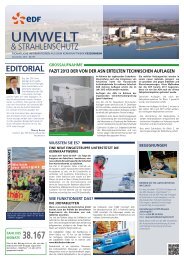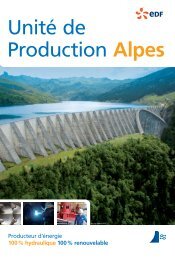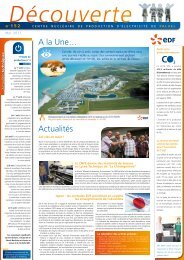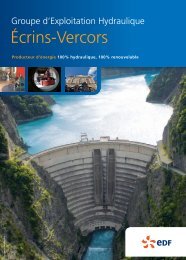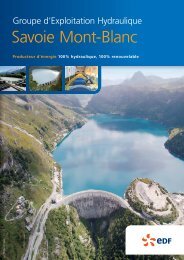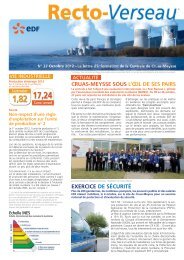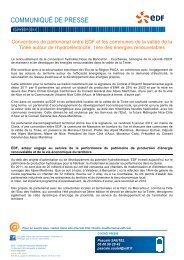Hydroelectric energy - Energie EDF
Hydroelectric energy - Energie EDF
Hydroelectric energy - Energie EDF
Create successful ePaper yourself
Turn your PDF publications into a flip-book with our unique Google optimized e-Paper software.
DID YOU KNOW?<br />
In order to generate electricity, hydroelectric plants<br />
release water from their dams. As a result, water fl ow<br />
and current increase downstream of the structure,<br />
potentially posing a risk to people in the vicinity or in<br />
the riverbed.<br />
Even so, these water releases are required in order to<br />
rotate turbines during periods of peak demand, to<br />
satisfy the needs of farmers and industrialists, to<br />
maintain a minimum fl ow that is compatible with<br />
downstream ecosystems, and to reduce high water<br />
levels. In order to mitigate this risk, information<br />
campaigns are regularly organized and 10 000 yellow<br />
signboards with the warning “Attention danger!” are<br />
placed along the banks of rivers, lakes and canals.<br />
CLOSELY MONITORED<br />
STRUCTURES<br />
Dams are affected by water mass and pressure, as well<br />
as by changes in temperature. The safety of hydroelectric<br />
plants therefore requires that each site and its facilities<br />
be kept under constant scrutiny. Dams are therefore<br />
constantly inspected and monitored. On the occasion of<br />
regulatory ten-year outages, dams may be drained in<br />
order to check the condition of sections that are normally<br />
submerged. Robots are sometimes used to avoid having<br />
to drain the dams.<br />
<strong>EDF</strong> AND THE<br />
PRESERVATION OF FLORA<br />
AND FAUNA<br />
<strong>EDF</strong> builds fi sh lifts and<br />
ladders to help migrating<br />
fi sh, such as salmon, over<br />
the dams.<br />
“What makes <strong>EDF</strong><br />
such a key player where<br />
water is concerned?”<br />
“<strong>EDF</strong> has always had a close<br />
relationship with water. In order to<br />
generate electricity, the company<br />
harnesses water directly as a driving<br />
force for its hydroelectric plants, and<br />
indirectly as a heat sink on its<br />
conventional and nuclear plants.<br />
However, water is also needed for<br />
other, equally important purposes<br />
such as public consumption,<br />
agriculture, industry and tourism.”<br />
“How is the just distribution<br />
of water guaranteed?”<br />
“One has to start by forecasting<br />
future water reserves on the basis of<br />
hydro-climatic factors such as snowfall<br />
or rainfall in catchment areas. It is the<br />
duty of the public authorities, in<br />
conjunction with various other players<br />
including local authorities and water<br />
agencies, to ensure that water is<br />
distribued fairly.”<br />
11



